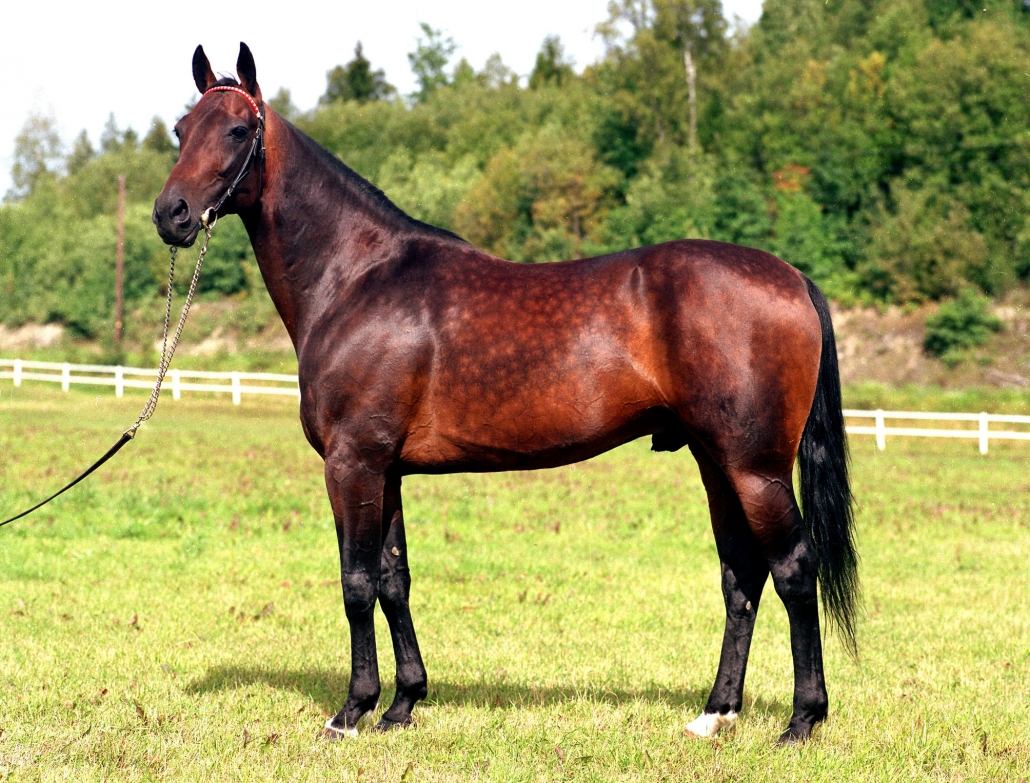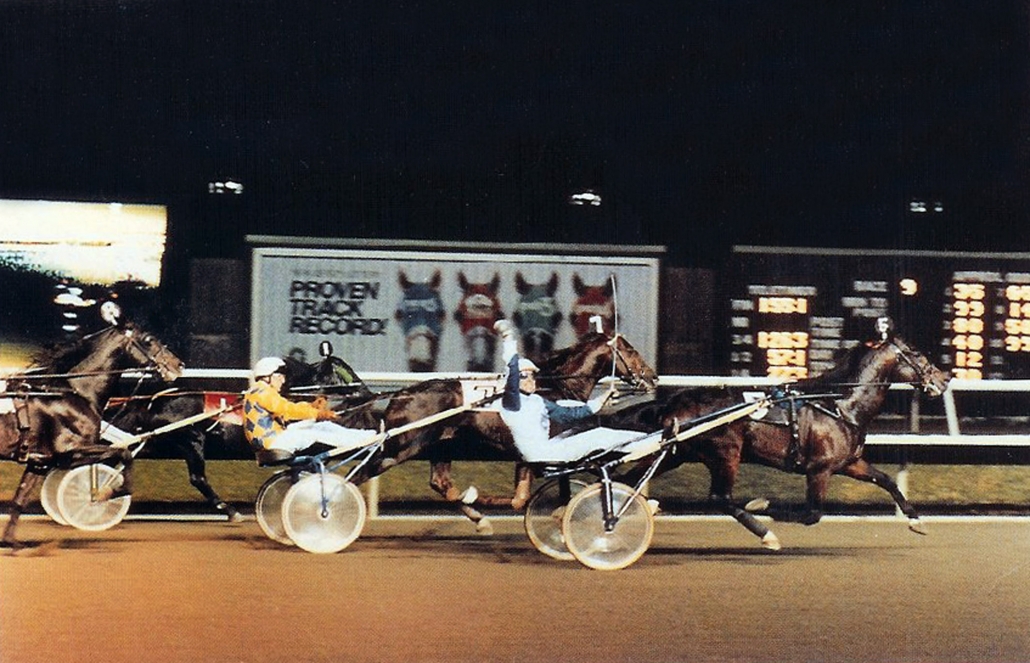Sugarcane Hanover
by Lisa Harkema
When Sugarcane Hanover sold at Harrisburg, Hanover president John Simpson bought him together with farm superintendent Peter Boyce for $15000. According to Dean Hoffman in his book Quest For Excellence, some people didn’t like the farm president bidding on a horse, feeling it was a buy-back or prearranged deal. However, Simpson and Boyce, had fallen in love with the son of Florida Pro and was buying the horse personally. At first attracted by his fluid and elegant gait, Simpson didn’t force Sugarcane at 2 but there was no question about his abilities. In his elimination heat of the Horseman Stake he beat Royal Prestige, winning in 1:58.3. Even though he finished third in the race-off behind Royal Prestige and Express Ride, he had shown what he was capable of. The young talent had one major weakness, however, which would affect him the rest of the freshman season. He suffered from sore hooves and occasionally made breaks, then after his 10th freshman start he developed a quarter crack. Not wanting to push him, Simpson simply decided to turn him out for the season.
Photos by Claes Kärrstrand
Return to the track in May, tragedy struck as the quarter cracks also returned and more time off was required. Not wanting to risk anything, Sugarcane Hanover was initially racing in overnight races against easy opposition but this was merely done to give the horse time to ready himself. His first meeting against some of the better horses in his crop came in the Matron at Garden State in mid-September where he met Hambletonian winner Nuclear Kosmos. Although losing to Mangrove and Stanley Dancer, Sugarcane was an encouraging second and had the best finish of all.
Going into the Kentucky Futurity in the beginning of October, Royal Prestige was the favorite and his record of 10-3 in 13 starts looked very impressive. Sugarcane’s 5-1-1 in 10 starts was quite good, and as it was clear he was starting to come into his own, he did get some press, too. «He is just coming around» said Simpson and added that «He’s a very fast horse who is much better than he has shown. He just might be the horse to beat in the whole thing.» Taking the early lead in the first elimination, he went on to win in 1:56 ahead of Mr Novak and Everglade Hanover. Royal Prestige then won the second elimination ahead of Victorious Tail and Mangrove. In the final, Sugarcane went into the lead but dropped back to third behind Everglade Hanover and Victorious Tail at the quarter. When Victorious Tail took the lead at the three quarter mark, closely followed by Royal Prestige, Sugarcane, sitting in fourth place, swung to the outside and pulled away for the win without much urging from Ron Waples, winning the final in 1:55.2.
A break caused him to lose the Geers to Everglade Hanover and he also finished second to him in their division of the Colonial. But mid-November at the Breeders Crown at Garden State Park, Sugarcane was back to his winning ways, sweeping past Nuclear Kosmos and Royal Prestige to win ahead of Everglade Hanover. Ron Waples commented after the race that «Sugarcane can accelerate faster than any trotter I’ve sat behind in my life.» The same group met a week later, again at Garden State, for the Shamrock and Sugarcane again prevailed, now beating Britelite Lobell by a nose with Royal Prestige in third.
In most cases Sugarcane would now have been retired to stud at Hanover but Simpson didn’t want to retire his star, because he, according to Hoffman’s book, «thought that perhaps Sugarcane’s best days lay ahead of him since he was finally sound.» That winter, Helmer Strombo from Norway contacted Simpson to offer him half a million dollars for his star trotter. Strombo later revealed how he took the hint, though, when the offer supposedly was refused before he had even managed to complete the sentence.
Letting Sugarcane again find his form in overnight races for almost no money, Simpson had a fresh horse in the important races. At the end of June, Sugarcane took home the Nat Ray, defeating Britelite Lobell and Express Ride. A week later he again beat Express Ride when his trademark finish netted him another Breeders Crown. Sitting 10 lengths behind the leading Express Ride at half, which was still 8 length at the third quarter pole, when Ron Waples asked for speed he got it in abundance and Sugarcane had no problems winning by 1 1/2 lengths. The following week he made a rare break in the American Trotting Championship which was won by Whip It Wood. But Sugarcane came back in formidable fashion in November, winning the van Lennep International at Pompano Park in 2:27.4 for a mile and a quarter (1:13.4), a world record according to the Americans (but Utah Bulwark had trotted 1:13.3 (equivalent to 2:27.2) over a slightly longer distance in April that year so it was technically just a North American record).
Voted Aged Trotter Of The Year, he would normally have attracted a lot of attention from foreign buyers. However, as Stig-H Johansson later said, nobody really thought he was for sale as he was widely expected to join the stallion ranks at Hanover Shoe Farms. That winter Gunnar Eggen, the Norwegian champion trainer, and Helmer Strombo were visiting Florida to buy a trotter through agent Stein Sjolie. They were annoyed to find out that he horse they were there to buy had already been sold. Well aware of Sugarcane’s fantastic 1987 season, Strombo was willing to significantly up last year’s failed bid. Travelling to Pennsylvania with a surprised Eggen, who later admitted that «I never thought it was possible to buy something like that,» this time Strombo offered Simpson a million dollars. The offer was firmly rejected but, in a change from a year prior, Simpson indicated he was willing to listen to offers. Eggen later told the story of what happened that day in the book «På Gullkantede Sko», saying «when we got there, the price was high. The negotiations went on all day while I was driving other horses. (…) It took a few hours and the price was eventually set at $2 million. Helmer came out to me, we went up to the track and talked about it for five minutes. Helmer wondered whether it was prudent to buy the horse for the price. Olle Goop had Grades Singing, who was the best in Scandinavia and in Europe and we knew what she had earned. I said that we probably wouldn’t do worse. The intention was to race Sugarcane for two years in Europe. I believed that we could earn 5-6 million (NOK, close to $1m USD) and with breeding income, too, it should be ok as long as the horse was fertile. Then Helmer felt it was okay. But he had to say yes before we departed from Hanover Shoe Farm that day. We could not leave, think it over and call again. So the contract was written then.»
American bred trotters had lost some of their glamor in Scandinavia in the 80s. The so-called stars often looked average when coming to the Elitlopp, European horses usually won the International Trot and European-bred horses, such as The Onion, Mon Tourbillon and Minou du Donjon, were starting to set world records at the mile-long distance, something previously unheard of. So when Sugarcane Hanover made his European debut at Åby in April 1988, he was only the bettors’ third choice, paying almost 6 times to win. European bettors would never make that mistake again. In the 2600 meter (1 5/8th mile) long race Gunnar Eggen got Sugarcane into a perfect position and attacked with slightly less than a half-mile to go. The leading Callit, winner of the 1987 International Trot, and the rest of the Swedish elite looked second-rate when Sugarcane delivered his trademark finish and left the rest of dead, winning by 20 or so lengths (!) Interviewed after the race, Eggen coolly stated that «I have driven many good horses in my life, but I have never ever sat behind anything like this.» According to the press, any doubt in the general superiority of US breeding at the time was eradicated by Sugarcane’s last lap at Åby. The next month he met the Scandinavian elite again in the 2100 meter (1 5/16th mile) Oslo Grand Prix. Sitting calmly outside the leading Rex Rodney, Gunnar Eggen engaged the turbo with half a lap to go on the 5/8 track and Sugarcane again left the rest in the dust, setting a world record for the distance with 1:12.5 (which is equivalent to 2:25.4 on a 1 1/4 mile), demolishing Utah Bulwark’s old record (1:13.3/2:27.2).
The 1988 Elitlopp was a real clash of titans, with Sugarcane going up against Mack Lobell and Napoletano. The rest of the European elite, except Ourasi, was also there but they were all playing second fiddle to the US bred trio. The first elimination caused everyone to gasp as Sugarcane threw himself in a wild break, losing 60-70 meters to the front runners, before Napoletano did the same in the first turn although losing only half as much ground. Simultaneously, Action Skoatter, the speedy yet uncontrollable Dutch roan mare, forced Pay Nibs to a 1:06 opening (roughly 26.4 quarter, although some reports have it a second faster!). Spotting the field far back Napoletano, with Sugarcane Hanover at his tail, caught up to the rest down the backstretch. Going into the last turn, the famous Elitlopp commentator Bosse Rydgren screamed in admiration that «behind Napoletano, Sugarcane is just jogging along, what animals!» During the last turn the duo started to go around the field. Coming out of the last turn, Eggen maneuvered Sugarcane four-wide and him and Napoletano battled it out down the final stretch with Sugarcane winning by a nose in 1:12.3 / 1:56.2. Many in the crowd just shook their heads in disbelief: Sugarcane’s performance was so extraordinary it simply took their breath away. Gunnar Eggen was not happy, however, as he realized the track was way too hard for Sugarcane’s delicate hooves. He demanded the crew water it as much as possible before the final. They also reshod him after the elimination and he got on better with the surface. In the final, however, Mack Lobell was dominant and it is doubtful whether Sugarcane, who had to settle for second place, could have beaten him anyway.
Throughout the summer Sugarcane won most of his races but his hooves and back were bothering him at times and caused him to make some seemingly unmotivated and unnecessary breaks. He wore custom made shoes and underwent regular acupuncture treatment to try to remedy all shortcomings. In July, Gunnar Eggen had to take a break from driving because of a terrible accident at Jarlsberg, as he drove Heilo Vestermarken that horse managed to get entangled with another trotter, Porsche Kosmos and while the latter was quickly taken care of and calmed down by Ulf Thoresen, Heilo Vestermarken, on the other hand, got more and more anxious and nervous every second. When Gunnar Eggen tried to calm him down things completely boiled over in his head: the horse bit Eggen hard in the arm and refused to let go of his arm for a long while. Eventually the horse let go but a big chunk of Eggen’s arm was badly damaged, the arm was broken in several places and tendons bitten off. Eggen was hospitalized for 2 weeks where they transplanted tendons from the thigh (but the bite still left permanent injuries). Sugarcane Hanover never gave anybody any problems, though,. According to caretaker Morten Waage, Sugarcane had the calm, gentle disposition of a gelding, claiming that «you could have picked him up and taken him to the movies» without problems.
Another clash of titans took place at Åby in mid-September. Making one of only 5 lifetime foreign starts, Ourasi came from France to challenge the Scandinavian elite in the Åby Stora Pris over 2100 meters (1 5/16th mile). As usual, Ourasi didn’t leave very fast but was quickly moved up outside the leading Meadow Roland. With 600 meters (3/8th) to go Sugarcane sat last when Eggen sent him forward. Rounding the field quickly, he worked his way around Ourasi at the end of the last turn. But two factors then came into play. Ourasi has a rather insane fighting spirit like nobody else and absolutely refuses to lose, so even though Sugarcane had a length on him he was in no way prepared to surrender – rather the opposite as he increased his speed hellbent on catching up to him and displays that characteristic Ourasi look where the ears to flat back and the head stretches forward. Moreover, Sugarcane was still bothered by his sore hooves and also some back problems. So with Ourasi mounting a comeback down the final stretch, Sugarcane’s gait got worse and worse and inevitably he broke stride. Despite appearing defeated at the top of the final stretch, Ourasi had managed to recover to pull off a fantastic comeback win. Yet the loss would pave the way for Sugarcane Hanover’s March of Dimes victory.
Exactly two months later the March of Dimes race was held at Garden State Park. Billed as the race of the century, it pitted Mack Lobell against Ourasi for the first and only time ever. However, all 10 participants were top-class trotters: Mack Lobell, Esotico Prad, Friendly Face, Callit, Sugarcane Hanover, Scenic Regal, Ourasi, Napoletano, Go Get Lost and No Sex Please. Four trotters came into the race with 5 straight wins (Mack Lobell, Napoletano, Callit and Ourasi) while two had four wins in their last five starts (Scenic Regal and No Sex Please) and all participants had at least two wins in their last five starts. As is well known, Sugarcane surprised many by winning ahead of Ourasi. In the book På Gullkantede Sko, Gunnar Eggen explained the race and his tactics: «I learned very much from Åby Stora Pris when we met Ourasi, when he galloped over the line. Had I not met Ourasi then I don’t know how it would have gone in America.
At Åby I attacked a little too early. Then Sugarcane was on the rebound, he had been out with a slight injury and his speed faded and he started losing his gait at the end. Ourasi was very slow that day, so had I been sitting quietly until 300 meters (3/16th mile) to go, I would have won. Before the race in America Helmer Strombo and I agreed that we should position the horse second or third over, but the tactics were changed on the way over and in the days before the race. We knew Ourasi was slow from the gate, and we knew Mack Lobell would take the lead. What I had not counted on was that Napoletano with Stig H Johansson, from post eight, would leave that fast from the gate. But Stig H had thought carefully about the race, too. He understood that it was about leaving quickly as many of those inside were not so fast out of the gate. He wanted to get Mack Lobell’s tail, which he did.
I was fifth or sixth into the first turn. Mack Lobell took the lead, Napoletano was trailing him and Callit was outside of them. I had Ourasi behind me. I knew then that Callit wanted cover. I had agreed in advance with Helmer that I would now try to get outside of Mack as fast as possible because we knew Ourasi would be going forward. When I started moving, I saw Ourasi come three-wide so I advanced forward but relinquished the position immediately. I was allowed to trail the front two until it was 150 meters (one-tenth mile) left. It is a 400 meters (quarter) final stretch, so it is not dangerous to sit quietly for a while.»
As Sugarcane had moved up outside Mack Lobell down the backstretch, US commentators shouted that «here comes Sugarcane, he’s going to take a shot at Mack Lobell» but Eggen’s comments reveal a more refined tactical approach. This also went back to Sugarcane’s first race in Europe. According to Eggen, «What characterized Sugarcane was that no matter how fast they drove in front he always had a finish and could accelerate without problems. We could sit in the pack going a quarter in 32 yet he could accelerate to 27 in no time. We saw this during Olympiatravet which was his first race in Scandinavia. Callit was in the lead, but it was as if they were driving the other way when I came with Sugarcane. I had gone fast with him the previous Tuesday in Gothenburg and knew he was good. But I didn’t realize he was that fast over short distances, even when the pace was high. I learned something there, that you could sit quietly with him for a long time if only there was a high tempo in the race.
Shortly after the race it was announced that Sugarcane Hanover would be retired to stud. He was the 29-4-5 in 56 starts with a lifetime mark of 1:54.3 / 1:11.2, earnings of 9 393 555 SEK (around 1.2 million USD). He would later be an outstanding stallion in Europe, being awarded the coveted Elite stallion status in Sweden and was champion stallion there in 1998. He also proved an excellent damsire.


